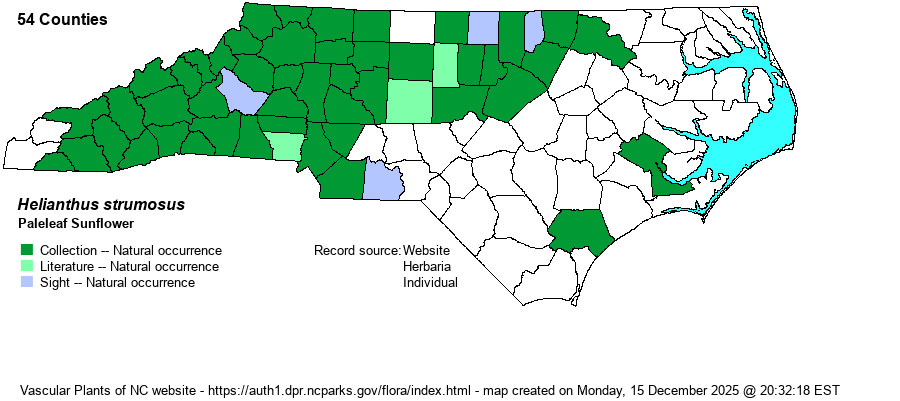| Author | L. | |
| Distribution | Mountains and most of the Piedmont; scarce in the southeastern Piedmont, and disjunct to two counties on the outer Coastal Plain. A number of photos on iNaturalist for "white" counties in the Piedmont may well be correct, but identification of sunflowers from photos is extremely difficult.
ME and Que. to ND, south to northern FL and TX. | |
| Abundance | Frequent to locally common in the Mountains and western Piedmont; fairly common in most of the central and northern Piedmont, but rare to very rare in the southeastern portions. Very rare in the lower Coastal Plain. | |
| Habitat | Mesic to dry, open woodlands, openings and edges of woodlands, overgrown fields, roadsides, powerline clearings. | |
| Phenology | Flowering and fruiting late July-September. | |
| Identification | Paleleaf Sunflower is a robust species often growing to 5-6 feet tall; it has a smooth stem (except perhaps in the inflorescence), which is also glaucescent. Leaves are opposite (the uppermost may be alternate), thick, very rough above, glaucescent or glaucous or short-hairy beneath, and lanceolate or narrowly ovate in shape. The apparently non-native H. tuberosus is similarly robust with large leaves, but its stem is rough-pubescent, at least near the base. It is also similar to H. decapetalus, but that species has thinner and more flexible leaves that are not whitened below, at least on the basal leaves; its leaves also are typically more strongly serrated and more acuminate toward the tip. H. laevigatus is similar but its leaves are smooth above, with a "rubbery" texture. This is a rather "standard" sunflower, looking like many species and growing in typical sunflower habitats; however, it is a large species with quite large flowers, often 3 inches across. | |
| Taxonomic Comments | None
| |
| Other Common Name(s) | Roughleaf Sunflower, Paleleaf Woodland Sunflower | |
| State Rank | S4 [S5] | |
| Global Rank | G5 | |
| State Status | | |
| US Status | | |
| USACE-agcp | UPL link |
| USACE-emp | FACU link |

